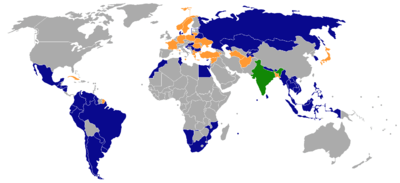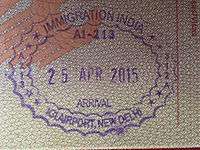Visa policy of India

Visitors to India must obtain a visa from an Indian diplomatic mission unless they come from one of the visa-exempt countries or a country whose citizens may obtain a visa online.[1]
Visa policy map

Visa-free entry
Citizens of the following countries do not require visas to enter India (unless arriving from mainland China), and may remain in the country without any limit of stay (unless otherwise noted):[1]
Foreign citizens possessing an Overseas Citizen of India registration certificate are also exempt from visa obligations. Citizens of Afghanistan, Bangladesh, Bhutan, mainland China, Nepal, Pakistan, or Sri Lanka are generally not entitled to hold Overseas Indian Citizenship.
Visa on arrival
Citizens of ![]() Japan can apply for visa on arrival in Bengaluru, Chennai, Delhi, Hyderabad, Kolkata or Mumbai since 1 March 2016. The visa is issued for business, tourist, medical and conference categories, and has a validity of 30 days.[2]
Japan can apply for visa on arrival in Bengaluru, Chennai, Delhi, Hyderabad, Kolkata or Mumbai since 1 March 2016. The visa is issued for business, tourist, medical and conference categories, and has a validity of 30 days.[2]
e-Tourist Visa
On 27 November 2014, the Electronic Travel Authorisation (ETA) facility became operational for citizens of over 40 eligible countries, including those who are eligible for visa on arrival. The list was further expanded to 113 countries in August 2015 (see chart below).[3] ETA is issued for tourism, visiting friends and family, short duration medical treatment and business visits. The scheme was renamed to e-Tourist Visa (eTV) on 15 April 2015.[4]
An application for e-Tourist Visa must be made at least four calendar days in advance of the date of arrival. The visa is valid for a single entry with a maximum stay of 30 calendar days from the date of arrival, and can be obtained twice in a calendar year. The duration of stay cannot be extended. The eTV fees are divided into four slabs of zero, US$25, US$48 and US$60, depending on nationality (based on reciprocity), plus a bank fee of 2.5% of the visa fee.[5]
e-Tourist Visa allows arrival at the following 16 airports:[6]
Citizens of the following countries and territories who hold ordinary passports are eligible to obtain the e-Tourist Visa (unless the citizen is of Pakistani origin):[7][8][9]
Note: Since 3 November 2015, the visa fee for citizens of
- countries with mark "1" are US $60
- countries with mark "2" are US $25
- countries with mark "3" are free of charge
- countries without mark are US $48
Reform
2013
In October 2013, India decided to initiate the process of extending visa-on-arrival access to 40 more nations.[10] In January 2014, plans were confirmed by Planning Minister of India.[11] The sixteen different types of visa would also be reduced to three: work, business and tourism.[12] The proposal initially met resistance from intelligence agencies and the possible problem of queues emerged.[13][14]
2014
In February 2014 it was announced that Indian intelligence agencies have given their approval to visa-on-arrival for up to 180 countries, largely due to the new possibilities provided by the Immigration, Visa and Foreigners' Registration and Tracking (IVFRT) system. The system would not be a typical visa on arrival in order to avoid clutter at the airports, but a system based on a prior online applications modelled after Australian Electronic Travel Authority system.[15][16][17]
On 5 February 2014 it was decided to introduce visa-on-arrival to tourists from 180 countries. Technical implementation, such as setting up the website for applications, is expected to take about 6 months and the authorities hope to have it in place for the tourist season beginning in October 2014. Prospective visitors will have to pay a fee and the electronic version of the visa should be granted within three days. The program is expected to apply to all international airports. However, nationals of Afghanistan, Iran, Iraq, Nigeria, Pakistan, Somalia, Sudan are to be excluded from this program.[18]
In July 2014 it was announced that India hopes to implement the program for citizens of 40 countries in the first phase by December 2014 and later on for 109 additional countries if the first phase is implemented successfully.[19]
In August 2014 it was revealed that ministries of tourism, home affairs and external affairs cannot agree on the list of countries for the ETA. Ministry of tourism proposed to allow the new system for the citizens of the 15 countries with the most visitors to India, Ministry of external affairs proposed to create a balanced list with some Asian and African countries while the Ministry of home affairs proposed to exclude all countries with high security concerns.[20]
In September 2014 Indian Prime Minister Narendra Modi announced that the United States would be added to the list of countries whose citizens may obtain a visa on arrival.[21] However, in October 2014 the planned introduction of the new e-Visa system was pushed from 2 October 2014 to June 2015.[22] It was also revealed that the list of visa on arrival countries is unlikely to be expanded in 2014.[23]
In November 2014 it was announced that the e-visa system might be rolled out for about 25 countries including the 13 countries which are currently eligible for visa on arrival.[24] Later that month it was announced that 28 countries would become eligible for an electronic visa on 27 November 2014 and that the list would include visa on arrival eligible countries as well as Brazil, Germany, Israel, Jordan, Mauritius, Norway, Palestine, Russia, Thailand, Ukraine, United Arab Emirates, United States.[25][26]
In November 2014, Indian Prime Minister announced visa on arrival facility for nationals of all Pacific countries and Australia.[27][28]
2015
The manual processing of the visa on arrival was discontinued in January 2015.[29] Until 26 January 2015, citizens of the following countries holding ordinary passports were granted visa on arrival without obtaining an ETA (unless they are of Bangladeshi or Pakistani origin), for a single stay up to 30 days in India when traveling as a tourist or for visiting family or friends:[1][30][29]
In February 2015, the Ministry of Tourism proposed extending the facility to citizens of China, United Kingdom, Spain, France, Italy and Malaysia.[31] Subsequently the Minister of Finance announced that the facility will be extended, in stages, to citizens of 150 countries.[32] In March 2015 it was announced that 53 nations were shortlisted for the second round of expansion of the system based on the number of tourist arrivals in the previous years.[33]
After the Government was criticised for naming the new policy "Visa on arrival" it decided to rename it to "e-Tourist Visa (eTV)" in April 2015.[34][35]
The e-Tourist Visa facility was extended to 31 new countries on 1 May 2015.[36]
In May 2015, Indian Foreign Ministry announced that Chinese citizens will be able to apply for e-Tourist Visa facility in order to coordinate Prime Minister Narendra Modi visiting China between 14 and 16 May. Disputes about Sino-Indian border and national security will be postponed.[37]
On 29 July 2015 Indian Ministry of Home Affairs announced the extension of e-Tourist Visa facility to China, Hong Kong and Macau with effect from 30 July 2015.[38]
The list of eligible nationalities has been extended with 36 new countries on 15 August 2015. On the same day the list of eTV airports has been expanded with 7 new airports.[8] The extension to 150 nationalities was scheduled to be finished by 31 March 2016.[39]
In September 2015 it was announced that the list will be expanded by another 37 countries.[40]
In January 2016 it was announced that the extension will take place by March 2016.[41] In November 2015 it was announced that the visa validity will be extended to 180 days.[42]
2016
In January 2016 it was announced that the multiple entries will become available and that eTourist Visa holders will receive a gift pack on arrival.[43]
The eTV list was extended for tourists from 37 more countries on 26 February 2016.[44]
In September 2016 it was announced that the electronic visa scheme will be reformed to include 27 visa codes denoting various visit purposes such as tourism, business or medical visits.[45] It was also announced that the list of visa on arrival eligible countries would be expanded.[46]
Costs for visa applications
Visa applications can be submitted in person or sent by post to an Indian consulate. It can also be submitted to designated Visa service provider in certain countries.[47] Costs differ per consulate and region. Some visa-handling services charge a small fee on top of it to check that completed application form meets all requirements and submit the documents on the applicant's behalf. [48]
Citizens of the following countries do not pay a visa fee — Afghanistan, Argentina, Bangladesh, DPR Korea, Jamaica, Maldives, Mauritius, Mongolia, Seychelles (up to 3 months), South Africa and Uruguay.[49]
Restricted and Protected Area Permits
A Protected Area Permit (PAP) is required to enter the states of Arunachal Pradesh and Sikkim and some parts of the states of Himachal Pradesh, Jammu and Kashmir, Rajasthan and Uttarakhand. A Restricted Area Permit (RAP) is required to enter the Andaman and Nicobar Islands and parts of Sikkim. Some of these requirements are occasionally lifted for a year at a time. Permits are not required for nationals of Bhutan travelling by air to/from Thimphu via Bagdogra and for nationals of Nepal travelling by air to/from Kathmandu (if travelling by land a pass issued by either the Foreigners Regional Registration Office, Superintendent of police or the diplomatic representation of India in Bhutan or Nepal is required).[1] Special permits are needed to enter Lakshadweep Islands. Maldivian citizens are allowed to visit Minicoy island for fifteen days if allowed by the High Commissioner of India to the Maldives.
Pakistani Passport Holders and Persons of Pakistani Origin
As of 21 March 2013, Pakistani citizens over the age of 65 with the sole objective of meetings friends or family are granted a 45-day visa upon arrival at the Attari-Wagah Checkpoint, so long as the applicant provides sponsor letters from their contacts in India.[50] This scheme does not apply for those who wish to visit Punjab, Kerala and Restricted Areas, nor does it apply to those who have ever been denied an Indian visa before.[50] Persons who ever held Pakistani citizenship, or who have a parent or spouse that held Pakistani citizenship are ineligible for India's new E-Visa scheme, and so must apply to their local Indian mission for visas. Applicants who once held Pakistani citizenship require lengthy processing times, while foreign spouses and those of Pakistani origin who never held Pakistani citizenship typically experience shorter processing times.[50] India also forbids Pakistani applicants with dual-nationality from applying on their non-Pakistani passport.[50]
Diplomatic or official passports

Holders of diplomatic or official passports of the following countries do not require a visa for India — Argentina, Bangladesh, Belarus, Brazil, Brunei, Bulgaria, Cambodia, Chile, Colombia, Croatia, Cyprus, Denmark, Ecuador, Egypt, El Salvador, Guatemala, Guyana, Honduras, Hungary, Indonesia, Israel, Kazakhstan, Kyrgyzstan, Laos, Malaysia, Mauritius, Mexico, Mongolia, Morocco, Mozambique, Myanmar, Namibia, Nicaragua, Paraguay, Peru, Philippines, Russia, Serbia, Singapore, South Africa, South Korea, Sri Lanka, Syria, Tajikistan, Thailand, Tunisia, Uruguay, Venezuela and Vietnam and diplomatic passports only of the following countries — Afghanistan, Armenia, Cuba, France, Germany, Greece, Japan, Lithuania, Macedonia, Malta, Norway, Poland, Romania, Sweden, Turkey, Turkmenistan and Ukraine.[1][51]
Visitor statistics
Most visitors arriving to India were from the following countries of nationality:[52]
| Country | 2015 | 2014 | 2013 |
|---|---|---|---|
| | 01 | 01 | 01 |
| | 02 | 02 | 03 |
| | 03 | 03 | 02 |
| | 04 | 04 | 04 |
| | 05 | 05 | 05 |
| | 06 | 06 | 08 |
| | 07 | 08 | 10 |
| | 08 | 09 | 06 |
| | 09 | 07 | 07 |
| | 10 | 10 | 09 |
| Total | 11 | 11 | 11 |
See also
References
- 1 2 3 4 5 "Visa Information - India". Timatic. IATA. Retrieved 15 November 2016.
- ↑ "Visa-on-arrival for Japanese citizens from tomorrow". The Times of India. Retrieved 12 July 2016.
- ↑ E-visa notification
- ↑ Government Changes Name of Visa on Arrival Scheme to E-Tourist Visa
- ↑ Country/Territory Wise e-Tourist Visa Fee
- ↑ Instructions for e-Tourist Visa
- ↑ Ministry of Home Affairs, Government of India. "e-TOURIST VISA (eTV)". India: National Informatics Centre. Retrieved 19 January 2016.
- 1 2 Press Note - Extension of e-Tourist Visa scheme to 36 more countries and 7 more airports from 15 August 2015
- ↑ E-tourist visa extended to 37 more nations
- ↑ http://news.in.msn.com/national/visa-on-arrival-for-40-more-nations
- ↑ "Visa on arrival for 40 more countries to be a reality soon". The Economic Times. 8 January 2014. Retrieved 19 January 2016.
- ↑ India revamps visa system to boost visitor numbers
- ↑ Visa-on-arrival facility extended to tourists from 180 countries
- ↑ Waiting time in immigration queues ‘has almost doubled’ at Mumbai airport
- ↑ Intel nod for visa-on-arrival
- ↑ India set to ease visa restrictions for 180 countries except Pakistan
- ↑ "India visa-on-arrival scheme to be extended". BBC. Retrieved 7 June 2014.
- ↑ India to extend visa-on-arrival to tourists from 180 countries
- ↑ India to Offer Electronic Visa for Canadians From December
- ↑ E-visa scheme hits inter-departmental roadblock
- ↑ Modi US visit: Visa on Arrival facility on anvil for US tourists
- ↑ E-visas may make visa-on-arrival redundant, says Tourism Minister Naik
- ↑ Visa on arrival faces project infra hurdle
- ↑ E-visa system likely to be rolled out next week
- ↑ US, Israel to be given e-visa facility from 27 November
- ↑ "US, Israel, Palestine to be given e-visa facility on Nov 27". Zee News. 14 November 2014. Retrieved 19 January 2016.
- ↑ "Modi announces visa on arrival for 14 Pacific Island countries". India Today. 19 November 2014. Retrieved 19 January 2016.
- ↑ "Modi assures visa on arrival for Australian tourists". The Hindu. 17 November 2014. Retrieved 19 January 2016.
- 1 2 Discontinuation of manual TVoA to 12 Nationals namely (Japan, Singapore, Philippines, Finland, Luxembourg , New Zealand , Cambodia, Laos, Vietnam, Myanmar, Indonesia and South Korea) w.e.f. 27.01.15
- ↑ Bureau of Immigration (India): Tourist Visa on Arrival
- ↑ India may extend e-visa facility to six more countries
- ↑ Budget 2015: Government to increase visa on arrival facilities to 150 countries, says FM Jaitley
- ↑ 53 nations to get nod for e-visa soon
- ↑ It's Not Visa-on-Arrival, Cedes Government, Scheme to be Renamed
- ↑ Govt decides to rename its e-visa scheme to 'Visa Online'
- ↑ e-Tourist Visa scheme extended to 31 more countries
- ↑ "Govt may snub agencies, clear e-visa for Chinese". The Times of India.
- ↑ Extension of e-Tourist Visa scheme to China, Hong Kong and Macau from tomorrow
- ↑ "E-tourist visa to be extended to 150 countries by March 31". The Economic Times. 14 August 2015. Retrieved 19 January 2016.
- ↑ e-visa facility to be extended to 37 more countries
- ↑ Govt on track to extend e-tourist visa facility to 150 nations
- ↑ India extends e-Visa scheme
- ↑ Govt mulls new e-visa rules: Multiple visits, 180-day validity in the pipeline
- ↑ Now, e-visa for tourists from 37 more nations
- ↑ Govt plans to modify e-tourist visa scheme, bring in coding
- ↑ Now, citizens of more nations set to get visa on arrival
- ↑ "Indian Embassy in US outsources Indian Visa Services to Cox & Kings". IANS. news.biharprabha.com. Retrieved 8 May 2014.
- ↑
- ↑ India Visa Information Belgium
- 1 2 3 4 http://www.india.org.pk/eoi.php?id=Visa%20on%20Arrival&q=1
- ↑ List of countries with which bilateral agreements on exemption from requirement of visa by diplomatic, official/service and ordinary passport holders are signed/currently in force
- ↑
External links
- Indian Visa Online, Government of India

